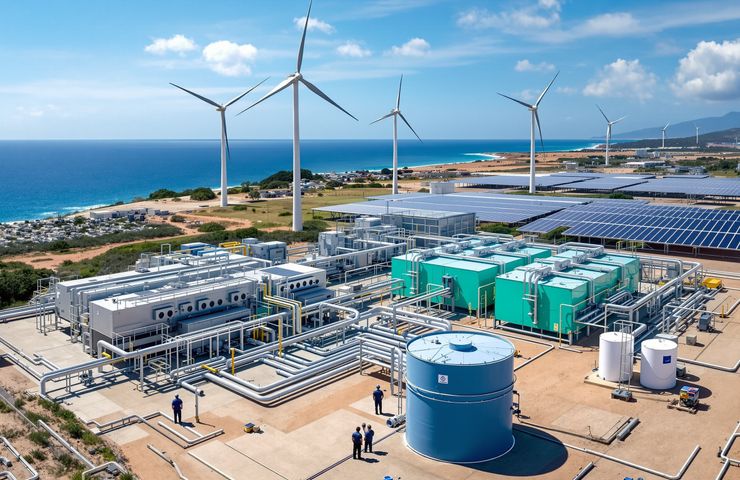
Hydrogen Production Boost: Siemens Energy and Techint Secure FEED for 210MW Electrolyser in Mexico
September 1, 2025Siemens Energy and Techint Engineering & Construction just clinched the FEED contract to build a 210 MW PEM electrolyser plant for Transition Industries’ Pacifico Mexinol project in Sinaloa, Mexico. Sealed on August 8, 2025, this deal marks a huge step forward in hydrogen production for green methanol, aiming for roughly 2.2 million tonnes per year once the plant fires up.
They’ll be leveraging the Elyzer P-300 unit, which uses a proton exchange membrane to split water into high-purity hydrogen (about 4,000 kg H₂/hour) and oxygen, all powered by renewable energy. That clean hydrogen then flows straight into a dedicated synthesis loop, churning out ultra-low-carbon methanol—an essential ingredient for decarbonizing the chemicals sector and shipping fuels.
Technical Snapshot
The Elyzer P-300 is designed for rapid scaling and grid-responsive operation. Its modular blocks deliver over 75% efficiency and pump out hydrogen with up to 99.9999% purity. After electrolysis, the gas is dried, optionally tweaked further, then compressed for storage or fed directly into the methanol synthesis train. This setup ticks all the boxes for industrial decarbonization and sustainable energy integration.
FEED Agreement Highlights
What really stands out is the fixed-price, binding FEED structure. It slaps a cap on costs before jumping into full EPC, meaning Transition Industries gets clear visibility on the budget—and won’t be blindsided by material price swings. Siemens Energy and Techint E&C take on the bulk of the pricing risk, covering detailed process design, equipment specs, and integration studies with the local grid and logistics network.
Why This Matters
Traditional methanol plants rely on natural gas steam reforming, belching out huge volumes of CO₂. By swapping in renewable-powered electrolysis, Pacifico Mexinol slashes that carbon footprint, offering a cleaner path for an industry responsible for hundreds of millions of tonnes of CO₂ each year.
Historical Context
Green methanol first made waves in Europe and Asia, with projects like European Energy’s Danish facility commissioning in 2024. Since then, electrolyser families like Siemens’ Silyzer and Elyzer have ballooned from single-digit MW units to these mid-hundreds. Mexico’s jump into standalone green methanol signals a real global pivot toward cleaner chemical supply chains.
Sinaloa—known for its agriculture and ports in Mazatlán and Topolobampo—checks all the boxes for large-scale electrolytic hydrogen. With an expanding renewable energy portfolio of wind, solar, and grid power, developers can chase full lifecycle decarbonization without worrying about intermittent supply.
Strategic and Economic Impact
Beyond cutting emissions, Pacifico Mexinol is expected to generate hundreds of local construction and operations jobs, fortify regional supply chains, and attract follow-on investments in clean energy. Mexico could soon be exporting e-methanol to Europe and Asia, where carbon regulations favor low-carbon imports. Plus, there’s upside in supplying hydrogen for local ammonia plants or fuel cell applications—diversifying revenue streams all around.
Global Context
As markets like the EU roll out Carbon Border Adjustment Mechanisms, low-carbon imports command a premium. Pacifico Mexinol’s locked-in cost structure and renewable baseline put Mexico in a prime position to serve European buyers with compliant green hydrogen–derived methanol, shipping it efficiently through Pacific ports.
Industry Trends
This isn’t a one-off. Siemens Energy’s partnership with Air Liquide to mass-produce gigawatt-scale electrolyzers in Berlin underscores the shift to industrial-scale green hydrogen. Modular platforms like Elyzer and Silyzer let developers deploy plants fast, while cost-cap FEED deals ease financing headaches. Expect similar tie-ups and innovative funding models to spring up across Asia and the Middle East soon.
Potential Challenges
- Water Demand: Electrolysis needs a steady water supply—securing sustainable sources is crucial in semi-arid Sinaloa.
- Grid Stability: Hooking a 210 MW load into local grids means careful planning, possible storage solutions, or demand-management tactics.
- Logistics & Export: Efficient port handling and solid shipping agreements will make or break the project’s success in global markets.
Looking Ahead
With construction slated to kick into full EPC mode by 2029, eyes will be on this model: Can a cost-capped FEED plus modular electrolysis deployment spark the next wave of sustainable energy and industrial decarbonization projects? And will other emerging economies follow suit? Ultimately, Pacifico Mexinol is more than a single plant—it’s a real-world test of whether large-scale, zero-emission chemical production can thrive commercially. If it works, we might just rewrite the playbook for how the world sources feedstock for plastics, fuels, and beyond.



 With over 15 years of reporting hydrogen news, we are your premier source for the latest updates and insights in hydrogen and renewable energy.
With over 15 years of reporting hydrogen news, we are your premier source for the latest updates and insights in hydrogen and renewable energy.